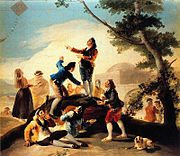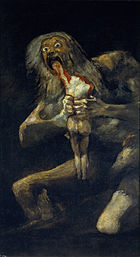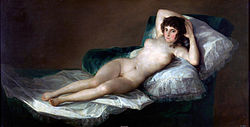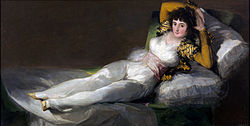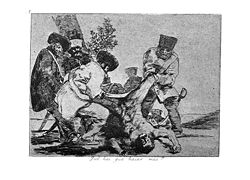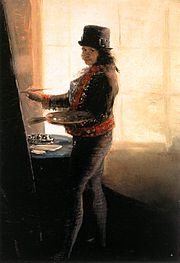
Francisco Goya
Background Information
SOS Children, an education charity, organised this selection. SOS Children has looked after children in Africa for forty years. Can you help their work in Africa?
| Francisco Goya | |
|---|---|
 Vicente López y Portaña Portrait of Francisco Goya, 1826, oil on canvas, 93 × 75 cm (36.61 × 29.53 in), Museo del Prado, Madrid, Spain |
|
| Birth name | Francisco José de Goya y Lucientes |
| Born | Fuendetodos |
| Nationality | Spanish |
| Field | Painting, Printmaking |
| Works |
The Parasol, ca. 1777 |
| Influenced | Édouard Manet, Pablo Picasso, Eduardo Úrculo |
Francisco José de Goya y Lucientes (30 March 1746 – 16 April 1828) was a Spanish romantic painter and printmaker regarded both as the last of the Old Masters and as the first of the moderns. Goya was a court painter to the Spanish Crown, and through his works was both a commentator on and chronicler of his era. The subversive and imaginative element in his art, as well as his bold handling of paint, provided a model for the work of later generations of artists, notably Manet and Picasso.
Biography
Youth
Goya was born in Fuendetodos, Aragón, Spain, in 1746 to José Benito de Goya y Franque and Gracia de Lucientes y Salvador. He spent his childhood in Fuendetodos, where his family lived in a house bearing the family crest of his mother. His father earned his living as a gilder. About 1749, the family bought a house in the city of Zaragoza and some years later moved into it. Goya may have attended school at Escuelas Pias, where he formed a close friendship with Martin Zapater. Their correspondence from the 1770s to the 1790s is a valuable source for understanding Goya's early career at the court of Madrid.
At age 14, he entered apprenticeship with the painter José Luzán. He later moved to Madrid where he studied with Anton Raphael Mengs, a painter who was popular with Spanish royalty. He clashed with his master, and his examinations were unsatisfactory. Goya submitted entries for the Royal Academy of Fine Art in 1763 and 1766, but was denied entrance.
He then journeyed to Rome, where in 1771 he won second prize in a painting competition organized by the City of Parma. Later that year, he returned to Zaragoza and painted parts of the cupolas of the Basilica of the Pillar (including Adoration of the Name of God), a cycle of frescoes in the monastic church of the Charterhouse of Aula Dei, and the frescoes of the Sobradiel Palace. He studied with Francisco Bayeu y Subías and his painting began to show signs of the delicate tonalities for which he became famous.
Maturity and success
Goya married Bayeu's sister Josefa (he nicknamed her "Pepa") on 25 July 1773. This marriage, and Francisco Bayeu's membership of the Royal Academy of Fine Art (from the year 1765) helped Goya to procure work as a painter of designs to be woven by Royal Tapestry Factory. There, over the course of five years, he designed some 42 patterns, many of which were used to decorate (and insulate) the bare stone walls of El Escorial and the Palacio Real del Pardo, the newly built residences of the Spanish monarchs near Madrid. This brought his artistic talents to the attention of the Spanish monarchs who later would give him access to the royal court. He also painted a canvas for the altar of the Church of San Francisco El Grande in Madrid, which led to his appointment as a member of the Royal Academy of Fine Art.
Painter of royalty
In 1783, the Count of Floridablanca, a favorite of King Carlos III, commissioned Goya to paint his portrait. He also became friends with Crown Prince Don Luis, and spent two summers with him, painting portraits of both the Infante and his family. During the 1780s, his circle of patrons grew to include the Duke and Duchess of Osuna, whom he painted, the King and other notable people of the kingdom.
In 1786, Goya was given a salaried position as painter to Charles III. After the death of Charles III in 1788 and revolution in France in 1789, during the reign of Charles IV, Goya reached his peak of popularity with royalty.
In 1789 Goya was made court painter to Charles IV and in 1799 he was appointed First Court Painter with a salary of 50,000 reales and 500 ducats for a coach. He painted the King and the Queen, royal family pictures, portraits of the Prince of the Peace and many other nobles. His portraits are notable for their disinclination to flatter, and in the case of Charles IV of Spain and His Family, the lack of visual diplomacy is remarkable. Modern interpreters have seen this portrait as satire; it is thought to reveal the corruption present under Charles IV. Under his reign his wife Louisa was thought to have had the real power, which is why she is placed at the centre of the group portrait. From the back left of the painting you can see the artist himself looking out at the viewer, and the painting behind the family depicts Lot and his daughters, thus once again echoing the underlying message of corruption and decay.
Goya received orders from many within the Spanish nobility. Among those from whom he procured portrait commissions were Pedro Téllez-Girón, 9th Duke of Osuna and his wife María Josefa Pimentel, 12th Countess-Duchess of Benavente, María del Pilar de Silva, 13th Duchess of Alba (universally known simply as the "Duchess of Alba"), and her husband José María Álvarez de Toledo, 15th Duke of Medina Sidonia, and María Ana de Pontejos y Sandoval, Marchioness of Pontejos.
Disease and deafness
At some time between late 1792 and early 1793, a serious illness, whose exact nature is not known, left Goya deaf, and he became withdrawn and introspective. During his recuperation, he undertook a series of experimental paintings. His experimental art—that would encompass paintings, drawings as well as a bitter series of aquatinted etchings, published in 1799 under the title Caprichos -- was done in parallel to his more official commissions of portraits and religious paintings. In 1798, he painted luminous and airy scenes for the pendentives and cupula of the Real Ermita (Chapel) of San Antonio de la Florida in Madrid. Many place miracles of Saint Anthony of Padua in the midst of contemporary Madrid.
Later years
French forces invaded Spain in 1808, leading to the Peninsular War (1808–1814). Goya's involvement with the court of the "Intruder king", Joseph I, the brother of Napoleon Bonaparte is not known: he did paint works for French patrons and sympathizers, but upon the restoration of the Spanish king, Ferdinand VII, in 1814, Goya denied any involvement with the intruder.
When his wife Josefa died in 1812, Goya was processing the war by painting The Charge of the Mamelukes and The Third of May 1808, and was preparing the series of prints known as The Disasters of War (Los desastres de la guerra).
King Ferdinand VII returned to Spain in 1814 but relations with Goya were not cordial. He painted portraits of the kings for a variety of organizations, but not for the king himself. In 1814, Goya was living with his housekeeper Doña Leocadia and her illegitimate daughter, Rosario Weiss; the young woman studied painting with Goya, who may have been her father. His works from 1814 to 1819 include commissioned portraits, the altarpiece of Santa Justa and Santa Rufina for the Cathedral of Seville, the print series of " La Tauromaquia" depicting scenes from bullfighting, and probably the etchings of " Los Disparates."
In 1819, with the idea of isolating himself, he bought a country house by the Manzanares river just outside of Madrid. It was known as the Quinta del Sordo (roughly, "House of the Deaf Man", titled after its previous owner and not after Goya himself). There he created the Black Paintings with intense, haunting themes, reflective of the artist's fear of insanity, and his outlook on humanity. Several of these, including Saturn Devouring His Son, were painted directly onto the walls of his dining and sitting rooms.
Goya left Spain in May 1824 for Bordeaux, where he settled, and Paris. He returned to Spain in 1826, but returned to Bordeaux, where he died in 1828 at the age of 82. He was of Catholic faith and was buried in Bordeaux; in 1919 his remains were transferred to the Royal Chapel of St. Anthony of La Florida in Madrid.
Works
Goya painted the Spanish royal family, which included Charles IV of Spain and Ferdinand VII. His themes range from merry festivals for tapestry, draft cartoons, to scenes of war and corpses. This evolution reflects the darkening of his temper. Modern physicians suspect that the lead in his pigments poisoned him and caused his deafness since 1792. Near the end of his life, he became reclusive and produced frightening and obscure paintings of insanity, madness, and fantasy. The style of these Black Paintings prefigure the expressionist movement. He often painted himself into the foreground.
The Maja
Two of Goya's best known paintings are The Nude Maja (La maja desnuda) and The Clothed Maja (La maja vestida). They depict the same woman in the same pose, naked and clothed, respectively. Without a pretense to allegorical or mythological meaning, the painting was "the first totally profane life-size female nude in Western art".
The identity of the Majas are uncertain. The most popularly cited subjects are the Duchess of Alba, with whom Goya was sometimes thought to have had an affair, and Pepita Tudó, mistress of Manuel de Godoy; Godoy subsequently owned them. Neither theory has been verified, and it remains as likely that the paintings represent an idealized composite.
The paintings were never publicly exhibited during Goya's lifetime. They were owned by Manuel de Godoy, the Prime Minister of Spain and a favorite of the Queen, María Luisa. In 1808 all Godoy's property was seized by Ferdinand VII after his fall from power and exile, and in 1813 the Inquisition confiscated both works as 'obscene', returning them in 1836 to the Academy of Fine Arts of San Fernando.
Darker realms
In a period of convalescence during 1793–1794, Goya completed a set of eleven small pictures painted on tin; the pictures known as Fantasy and Invention mark a significant change in his art. These paintings no longer represent the world of popular carnival, but rather a dark, dramatic realm of fantasy and nightmare. Courtyard with Lunatics is a horrifying and imaginary vision of loneliness, fear and social alienation, a departure from the rather more superficial treatment of mental illness in the works of earlier artists such as Hogarth. In this painting, the ground, sealed by masonry blocks and iron gate, is occupied by patients and a single warden. The patients are variously staring, sitting, posturing, wrestling, grimacing or disciplining themselves. The top of the picture vanishes with sunlight, emphasizing the nightmarish scene below.
This picture can be read as an indictment of the widespread punitive treatment of the insane, who were confined with criminals, put in iron manacles, and subjected to physical punishment. And this intention is to be taken into consideration since one of the essential goals of the enlightenment was to reform the prisons and asylums, a subject common in the writings of Voltaire and others. The condemnation of brutality towards prisoners (whether they were criminals or insane) was the subject of many of Goya’s later paintings.
As he completed this painting, Goya was himself undergoing a physical and mental breakdown. It was a few weeks after the French declaration of war on Spain, and Goya’s illness was developing. A contemporary reported, “the noises in his head and deafness aren’t improving, yet his vision is much better and he is back in control of his balance.” His symptoms may indicate a prolonged viral encephalitis or possibly a series of miniature strokes resulting from high blood pressure and affecting hearing and balance centers in the brain. The triad of tinnitus, episodes of imbalance and progressive deafness is also typical of Ménière's disease. Other postmortem diagnostic assessment points toward paranoid dementia due to unknown brain trauma (perhaps due to the unknown illness which he reported). If this is the case, from here on—we see an insidious assault of his faculties, manifesting as paranoid features in his paintings, culminating in his black paintings and especially Saturn Devouring His Sons.
Caprichos
In 1799 Goya published a series of 80 prints titled Caprichos depicting what he called
| “ | ...the innumerable foibles and follies to be found in any civilized society, and from the common prejudices and deceitful practices which custom, ignorance, or self-interest have made usual. | ” |
The dark visions depicted in these prints are partly explained by his caption, "The sleep of reason produces monsters". Yet these are not solely bleak in nature and demonstrate the artist's sharp satirical wit, particularly evident in etchings such as Hunting for Teeth. Additionally, one can discern a thread of the macabre running through Goya's work, even in his earlier tapestry cartoons.
In The Third of May, 1808: The Execution of the Defenders of Madrid, Goya attempted to "perpetuate by the means of his brush the most notable and heroic actions of our glorious insurrection against the Tyrant of Europe" The painting does not show an incident that Goya witnessed; rather it was meant as more abstract commentary.
Black Paintings and The Disasters of War
In later life Goya bought a house, called Quinta del Sordo ("Deaf Man's House"), and painted many unusual paintings on canvas and on the walls, including references to witchcraft and war. One of these is the famous work Saturn Devouring His Son (known informally in some circles as Devoration or Saturn Eats His Child), which displays a Greco-Roman mythological scene of the god Saturn consuming a child, possibly a reference to Spain's ongoing civil conflicts. Moreover, the painting has been seen as "the most essential to our understanding of the human condition in modern times, just as Michelangelo's Sistine ceiling is essential to understanding the tenor of the 16th century".
This painting is one of 14 in a series known as the Black Paintings. After his death the wall paintings were transferred to canvas and remain some of the best examples of the later period of Goya's life when, deafened and driven half-mad by what was probably an encephalitis of some kind, he decided to free himself from painterly strictures of the time and paint whatever nightmarish visions came to him. Many of these works are in the Prado museum in Madrid.
In the 1810s, Goya created a set of aquatint prints titled The Disasters of War which depict scenes from the Peninsular War. The scenes are singularly disturbing, sometimes macabre in their depiction of battlefield horror, and represent an outraged conscience in the face of death and destruction. The prints were not published until 1863, 35 years after Goya's death.
Questions of authenticity
The findings of research published since 2003 have raised questions regarding the authenticity of some of Goya's late works. One study claims that the Black Paintings were applied to walls that did not exist in Goya's home before he left for France. In 2008 the Prado Museum reverted the traditional attribution of The Colossus, and expressed doubts over the authenticity of three other paintings attributed to Goya as well. On 27 January 2009, the Prado announced they had come to the conclusion that The Colossus was painted by one of Goya's apprentices and even bore the signature of the painter. Doubts over its authenticity began in 1992 when the painting was cleaned and the curators of the museum noticed that the technique was much poorer than Goya's other masterpieces.
Portrayals and inspirations
Enrique Granados composed a piano suite (1911) and later an opera (1916), both called Goyescas, inspired by the artist's paintings. Mario CastelNuovo Tedesco wrote 24 classical guitar pieces, opus 195 (1968) inspired from the Caprichos. Gian Carlo Menotti wrote a biographical opera about him titled Goya (1986), commissioned by Plácido Domingo, who created the role; this production has been presented on television.
Several films portray Goya's life. These include a short film, Goya (1948), The Naked Maja (1958), Goya, historia de una soledad (1971), Goya in Bordeaux (1999), Volavérunt (1999), Goya : Awakened in a Dream (1999), and Goya's Ghosts (2006).

